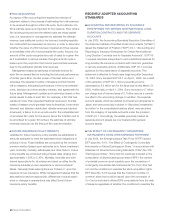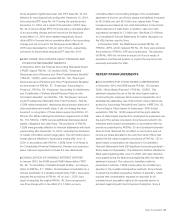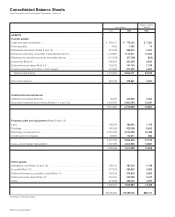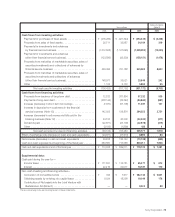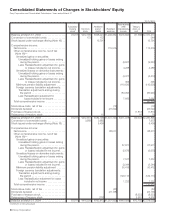Sony 2005 Annual Report Download - page 73
Download and view the complete annual report
Please find page 73 of the 2005 Sony annual report below. You can navigate through the pages in the report by either clicking on the pages listed below, or by using the keyword search tool below to find specific information within the annual report.70 Sony Corporation
Notes: 1. U.S. dollar amounts have been translated from yen, for convenience only, at the rate of ¥107=U.S. $1, the approximate Tokyo foreign exchange market rate as of
March 31, 2005.
2. In July 2003, the Accounting Standards Executive Committee of American Institute of Certified Public Accountants (“AcSEC”) issued Statement of Position (“SOP”)
03-1, “Accounting and Reporting by Insurance Enterprises for Certain Nontraditional Long-Duration Contracts and for Separate Accounts”. SOP 03-1 requires
insurance enterprises to record additional reserves for long-duration life insurance contracts with minimum guarantee or annuity receivable options. Additionally,
SOP 03-1 provides guidance for the presentation of separate accounts. This statement is effective for fiscal years beginning after December 15, 2003. Sony
adopted SOP 03-1 on April 1, 2004. As a result of the adoption of SOP 03-1, Sony’s operating income decreased by ¥5,156 million ($48 million) for the year
ended March 31, 2005. Additionally, on April 1, 2004, Sony recognized ¥4,713 million ($44 million) of loss (net of income taxes of ¥2,675 million) as a cumulative
effect of an accounting change. In addition, the separate account assets, which are defined by insurance business law in Japan and were previously included in
“Securities investments and other” on the consolidated balance sheet, were excluded from the category
of separate accounts under the provision of SOP 03-1. Accordingly, the assets previously treated as separate account assets are now treated within general
account assets.
3. In July 2004, the Emerging Issues Task Force (“EITF”) issued EITF Issue No. 04-8, “The Effect of Contingently Convertible Instruments on Diluted Earnings per
Share”. In accordance with Statement of Financial Accounting Standards (“FAS”) No. 128, Sony had not previously included in the computation of diluted earnings
per share (“EPS”) the number of potential shares of common stock issuable upon the conversion of contingently convertible debt instruments (“Co-Cos”) that have
not met the conditions to exercise the associated stock acquisition rights. EITF Issue No. 04-8 requires that the maximum number of shares of common stock
that could be issued upon the conversion of Co-Cos be included in diluted EPS computations from the date of issuance regardless of whether the conditions to
exercise such rights have been met. EITF Issue No. 04-8 is effective for reporting periods ending after December 15, 2004. Sony adopted EITF Issue No. 04-8
during the quarter ended December 31, 2004. As a result of the adoption of EITF Issue No. 04-8, Sony’s diluted EPS of income before cumulative effect of an
accounting change and its net income for the year ended March 31, 2004 were restated respectively. Sony’s diluted EPS of income before cumulative effect of an
accounting change and its net income for the year ended March 31, 2005 were decreased by ¥7.26 ($0.07) and ¥7.06 ($0.07), respectively, compared to those
before the adoption of EITF Issue No. 04-8.
4. In January 2003, the Financial Accounting Standards Board (“FASB”) issued FASB Interpretation (“FIN”) No. 46, “Consolidation of Variable Interest Entities—an
Interpretation of ARB No. 51”. FIN No. 46 addresses consolidation by a primary beneficiary of a variable interest entity (“VIE”). Sony early adopted the provisions of
FIN No. 46 on July 1, 2003.
As a result of adopting the original FIN No. 46, Sony recognized a one-time charge with no tax effect of ¥2,117 million as a cumulative effect of accounting
change in the consolidated statement of income, and Sony’s assets and liabilities increased by ¥95,255 million and ¥97,950 million, respectively. These increases
were treated as non-cash transactions in the consolidated statement of cash flows. In addition, cash and cash equivalents increased by ¥1,521 million.
See Note 23 for further discussion on the VIEs that are used by Sony.
In December 2003, the FASB issued revised FIN No. 46 (“FIN No. 46R”), which replaced FIN No. 46. Sony early adopted the provisions of FIN No. 46R upon its
issuance. The adoption of FIN No. 46R did not have an impact on Sony’s results of operations and financial position or impact the way Sony had previously
accounted for VIEs.
5. On April 1, 2001, Sony adopted FAS No.133, “Accounting for Derivative Instruments and Hedging Activities” as amended by FAS No. 138, “Accounting for Certain
Derivative Instruments and Certain Hedging Activities—an Amendment of FASB Statement No. 133”. As a result, Sony’s operating income, income before income
taxes and net income for the year ended March 31, 2002 decreased by ¥3,007 million, ¥3,441 million and ¥2,167 million, respectively. Additionally, Sony recorded
a one-time non-cash after-tax unrealized gain of ¥1,089 million in accumulated other comprehensive income in the consolidated balance sheet, as well as an after-
tax gain of ¥5,978 million in the cumulative effect of accounting changes in the consolidated statement of income.
6. In July 2001, the FASB issued FAS No. 142, “Goodwill and Other Intangible Assets”. Sony adopted FAS No. 142 retroactive to April 1, 2001. As a result, Sony’s
operating income and income before income taxes for the year ended March 31, 2002 increased by ¥20,114 million and income before cumulative effect of
accounting changes as well as net income for the year ended March 31, 2002 increased by ¥18,932 million.
7. In June 2000, AcSEC issued SOP 00-2, “Accounting by Producers or Distributors of Films”. Sony adopted SOP 00-2 retroactive to April 1, 2000. As a result,
Sony’s net income for the year ended March 31, 2001 included a one-time, non-cash charge with no tax effect of ¥101.7 billion, primarily to reduce the carrying
value of its film inventory.
8. In December 1999, the Securities and Exchange Commission issued Staff Accounting Bulletin (“SAB”) No. 101, “Revenue Recognition in Financial Statements”.
Sony adopted SAB No. 101 in the fourth quarter ended March 31, 2001 retroactive to April 1, 2000. As a result, a one-time no-cash cumulative effect adjustment
of ¥2.8 billion was recorded in the income statement directly above the caption of “net income” for a change in accounting principle. In December 2003, SAB No.
101 was amended by SAB No. 104, “Revenue Recognition”. The amendment did not have an impact on Sony’s results of operations and financial position.
BH6/30 Adobe PageMaker 6.0J /PPC








